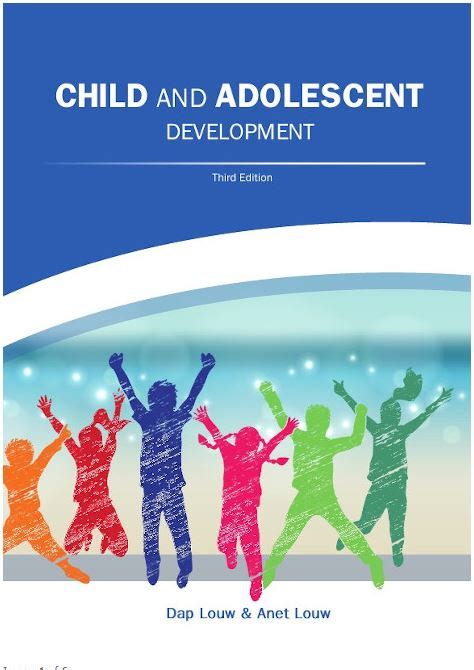

8 Must-Know Theories on Child and Adolescent Development (3rd Edition)
Essential Reading for Educators in 2025
Introduction

Child and adolescent development is a complex and dynamic field, with new research emerging all the time. As educators, it is essential to stay up-to-date on the latest theories and findings in order to provide the best possible education for our students.
This article will provide an overview of eight must-know theories on child and adolescent development. These theories will help you to understand the cognitive, social, emotional, and physical changes that occur during these critical periods of life.
1. Piaget’s Theory of Cognitive Development
Jean Piaget’s theory of cognitive development is one of the most influential theories in the field. Piaget believed that children’s thinking develops through a series of stages, each of which is characterized by different cognitive abilities.
The four stages of Piaget’s theory are:
- Sensorimotor stage (birth to 2 years): During this stage, infants learn about the world through their senses and motor skills.
- Preoperational stage (2 to 7 years): During this stage, children begin to use symbols and language to represent their thoughts. However, their thinking is still egocentric and they have difficulty understanding the perspectives of others.
- Concrete operational stage (7 to 11 years): During this stage, children become more logical and able to think about concrete objects and events. They can also understand the perspectives of others.
- Formal operational stage (11 years and up): During this stage, adolescents develop the ability to think abstractly and reason about hypothetical situations.
2. Vygotsky’s Theory of Social Development
Lev Vygotsky’s theory of social development emphasizes the role of social interaction in cognitive development. Vygotsky believed that children learn best through interactions with more knowledgeable peers and adults.
Vygotsky’s theory includes the following key concepts:
- The zone of proximal development: This is the range of tasks that a child can complete with assistance from an adult or more knowledgeable peer.
- Scaffolding: This is the process by which adults and more knowledgeable peers provide support and guidance to children as they learn new tasks.
- Social constructivism: This is the idea that knowledge is constructed through social interactions.
3. Erikson’s Theory of Psychosocial Development
Erik Erikson’s theory of psychosocial development focuses on the emotional and social development of children and adolescents. Erikson believed that individuals progress through a series of eight stages, each of which presents a different challenge or crisis.
The eight stages of Erikson’s theory are:
- Infancy (birth to 1 year): The crisis is trust vs. mistrust.
- Early childhood (1 to 3 years): The crisis is autonomy vs. shame and doubt.
- Play age (3 to 6 years): The crisis is initiative vs. guilt.
- School age (6 to 11 years): The crisis is industry vs. inferiority.
- Adolescence (11 to 18 years): The crisis is identity vs. role confusion.
- Young adulthood (18 to 40 years): The crisis is intimacy vs. isolation.
- Adulthood (40 to 65 years): The crisis is generativity vs. stagnation.
- Maturity (65 years and up): The crisis is integrity vs. despair.
4. Kohlberg’s Theory of Moral Development
Lawrence Kohlberg’s theory of moral development focuses on the development of moral reasoning. Kohlberg believed that individuals progress through a series of six stages, each of which is characterized by different moral principles.
The six stages of Kohlberg’s theory are:
- Pre-conventional level (ages 4 to 10): At this level, children’s moral reasoning is based on obedience to authority and the avoidance of punishment.
- Conventional level (ages 10 to 13): At this level, children’s moral reasoning is based on social conventions and the expectations of others.
- Post-conventional level (ages 13 and up): At this level, individuals’ moral reasoning is based on abstract principles of justice and equality.
5. Bandura’s Theory of Social Learning
Albert Bandura’s theory of social learning emphasizes the role of observation and imitation in learning. Bandura believed that children learn by observing the behavior of others, and that they are more likely to imitate behavior that is rewarded or reinforced.
Bandura’s theory includes the following key concepts:
- Modeling: This is the process by which children learn by observing the behavior of others.
- Vicarious reinforcement: This is the process by which children are reinforced for observing the behavior of others.
- Self-efficacy: This is the belief that one can successfully complete a task.
6. Attachment Theory
Attachment theory focuses on the development of close emotional bonds between children and their caregivers. Attachment theory was developed by John Bowlby and Mary Ainsworth.
Attachment theory includes the following key concepts:
- Attachment styles: There are four main attachment styles: secure attachment, insecure-avoidant attachment, insecure-ambivalent attachment, and disorganized attachment.
- Attachment security: Children who have secure attachments are more likely to be happy, confident, and successful in life.
- Attachment insecurity: Children who have insecure attachments are more likely to be anxious, withdrawn, and aggressive.
7. The Bioecological Model of Human Development
The bioecological model of human development was developed by Urie Bronfenbrenner. This model emphasizes the role of the environment in human development.
The bioecological model includes the following key concepts:
- Microsystem: This is the immediate environment in which children live, such as their family, school, and peer group.
- Mesosystem: This is the interaction between the microsystems in which children live.
- Exosystem: This is the environment outside of children’s immediate environment, such as their parents’ workplace or their community.
- Macrosystem: This is the cultural and economic context in which children live.
- Chronosystem: This is the historical and cultural context in which children live.
8. Positive Youth Development
Positive youth development is a strengths-based approach to child and adolescent development. This approach focuses on helping children and adolescents develop their strengths and resilience.
Positive youth development includes the following key concepts:
- Five Cs of positive youth development: These are competence, confidence, connection, character, and caring.
- Resilience: This is the ability to bounce back from adversity.
- Strengths-based approach: This is an approach that focuses on helping children and adolescents develop their strengths and resilience.
Conclusion
These eight theories provide a comprehensive overview of the field of child and adolescent development. By understanding these theories, educators can better understand the cognitive, social, emotional, and physical changes that occur during these critical periods of life. This knowledge can help educators to create a more supportive and nurturing learning environment for all students.
Additional Resources
- The National Association for the Education of Young Children (NAEYC)
- The National Institute of Child Health and Human Development (NICHD)
- The American Psychological Association (APA)
References
- Berk, L. E. (2018). Child development (10th ed.). New York, NY: Pearson.
- Bornstein, M. H., & Lamb, M. E. (2018). Developmental psychology: An introduction (9th ed.). New York, NY: Routledge.
- Papalia, D., & Martorell, G. (2017). Child development (12th ed.). New York, NY: McGraw-Hill Education.










